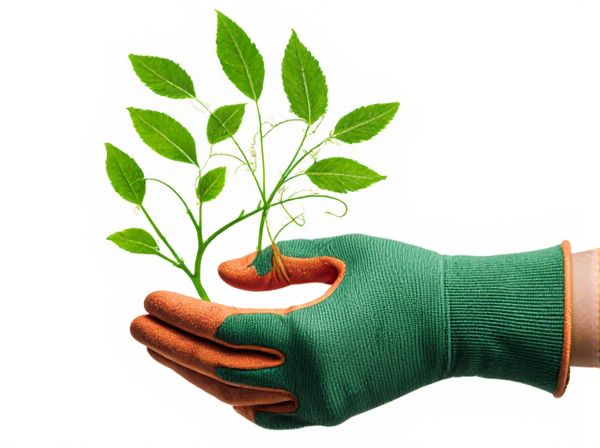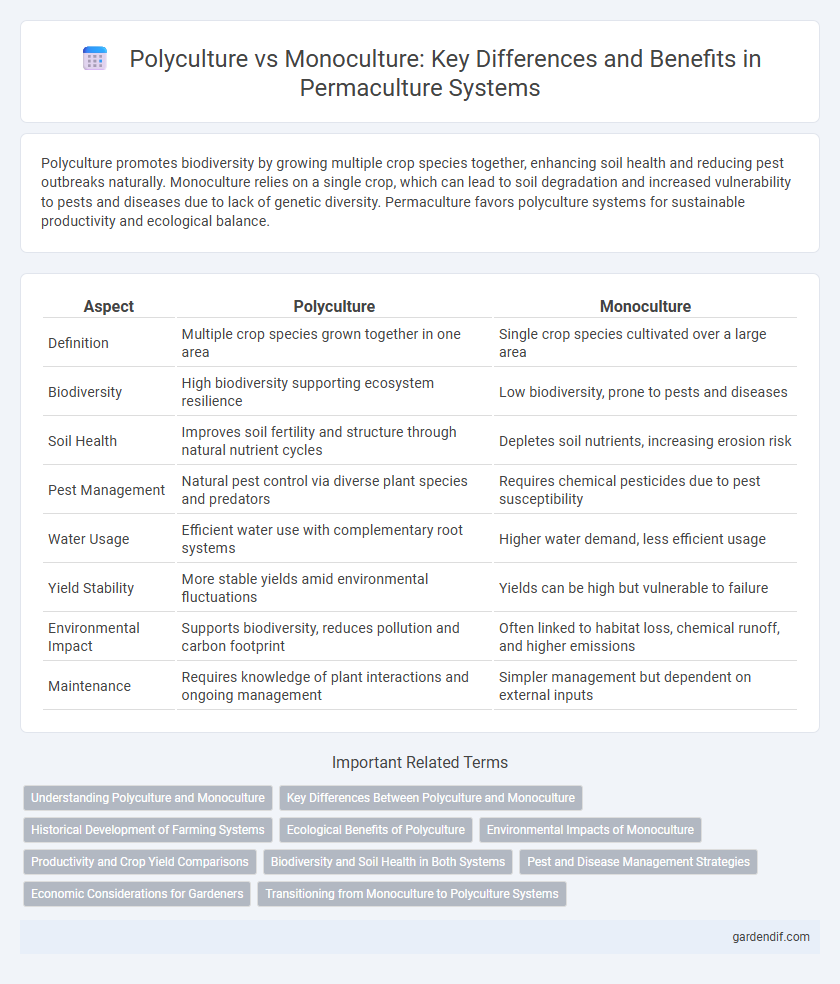
Polyculture vs Monoculture Illustration
Polyculture promotes biodiversity by growing multiple crop species together, enhancing soil health and reducing pest outbreaks naturally. Monoculture relies on a single crop, which can lead to soil degradation and increased vulnerability to pests and diseases due to lack of genetic diversity. Permaculture favors polyculture systems for sustainable productivity and ecological balance.
Table of Comparison
| Aspect | Polyculture | Monoculture |
|---|---|---|
| Definition | Multiple crop species grown together in one area | Single crop species cultivated over a large area |
| Biodiversity | High biodiversity supporting ecosystem resilience | Low biodiversity, prone to pests and diseases |
| Soil Health | Improves soil fertility and structure through natural nutrient cycles | Depletes soil nutrients, increasing erosion risk |
| Pest Management | Natural pest control via diverse plant species and predators | Requires chemical pesticides due to pest susceptibility |
| Water Usage | Efficient water use with complementary root systems | Higher water demand, less efficient usage |
| Yield Stability | More stable yields amid environmental fluctuations | Yields can be high but vulnerable to failure |
| Environmental Impact | Supports biodiversity, reduces pollution and carbon footprint | Often linked to habitat loss, chemical runoff, and higher emissions |
| Maintenance | Requires knowledge of plant interactions and ongoing management | Simpler management but dependent on external inputs |
Understanding Polyculture and Monoculture
Polyculture involves growing multiple crop species in the same space, enhancing biodiversity, soil health, and resilience against pests and diseases. Monoculture, by contrast, cultivates a single crop over large areas, which can lead to soil depletion, increased vulnerability to pests, and higher dependence on chemical inputs. Understanding these methods highlights that polyculture supports sustainable agriculture by mimicking natural ecosystems, whereas monoculture prioritizes high yields but often at environmental and ecological costs.
Key Differences Between Polyculture and Monoculture
Polyculture involves growing multiple crop species simultaneously in the same space, promoting biodiversity and ecosystem resilience, while monoculture cultivates a single crop species over large areas, increasing vulnerability to pests and diseases. Polyculture enhances soil health through diverse root systems and organic matter input, whereas monoculture often leads to soil degradation and nutrient depletion due to repetitive planting. The diverse plant interactions in polyculture improve pest control and reduce the need for chemical inputs, contrasting with monoculture's reliance on pesticides and fertilizers to maintain yield.
Historical Development of Farming Systems
Polyculture and monoculture represent two distinct historical farming systems, with monoculture becoming dominant during the Agricultural Revolution due to its efficiency in crop specialization and mechanization. Early societies practiced polyculture, cultivating diverse crops together to enhance soil fertility, pest control, and resilience against climate variability. Modern permaculture revives these ancient polyculture principles, emphasizing sustainable and regenerative agriculture in contrast to the industrial monoculture's environmental depletion.
Ecological Benefits of Polyculture
Polyculture enhances biodiversity by supporting diverse plant and animal species, leading to improved ecosystem resilience and natural pest control. This farming method promotes soil health through varied root structures that increase nutrient cycling and reduce erosion. In contrast to monoculture's vulnerability to pests and diseases, polyculture fosters ecological balance and sustainable resource use.
Environmental Impacts of Monoculture
Monoculture farming significantly depletes soil nutrients, leading to increased reliance on chemical fertilizers and reduced soil fertility over time. It also heightens vulnerability to pests and diseases, often resulting in extensive pesticide use that harms local biodiversity and pollinators. This practice contributes to soil erosion and decreases carbon sequestration capacity, exacerbating environmental degradation and climate change effects.
Productivity and Crop Yield Comparisons
Polyculture systems enhance productivity by cultivating diverse crops simultaneously, which improves resource utilization, pest resistance, and soil health, leading to higher overall crop yields compared to monoculture. Monoculture farming often results in soil nutrient depletion, increased vulnerability to pests and diseases, and lower long-term sustainability of crop yield. Studies show polyculture plots can produce up to 30-50% greater biomass and food output per unit area than monoculture systems.
Biodiversity and Soil Health in Both Systems
Polyculture enhances biodiversity by cultivating multiple plant species simultaneously, which supports diverse microbial communities and improves soil health through natural nutrient cycling. Monoculture often leads to reduced biodiversity and soil degradation due to repetitive planting of a single crop, increasing vulnerability to pests and requiring synthetic fertilizers. Healthy soil structure and nutrient balance in polyculture systems contribute to sustainable agriculture and long-term ecosystem resilience.
Pest and Disease Management Strategies
Polyculture enhances pest and disease control by increasing biodiversity, which naturally disrupts pest life cycles and reduces host plant density, limiting outbreaks. Monoculture's uniform crop environment often leads to rapid pest and disease spread, necessitating higher pesticide use. Integrating multiple plant species in permaculture systems promotes beneficial insects and microbial activity, creating a resilient ecosystem that mitigates pest pressure sustainably.
Economic Considerations for Gardeners
Polyculture enhances economic resilience for gardeners by diversifying crop yields, reducing the risk of total loss from pests or market fluctuations. Monoculture often offers higher short-term profitability due to mechanization efficiencies and simplified management but increases vulnerability to disease outbreaks and soil depletion. Investing in polyculture systems promotes long-term sustainability and cost savings through natural pest control and improved soil health.
Transitioning from Monoculture to Polyculture Systems
Transitioning from monoculture to polyculture systems enhances biodiversity, soil health, and pest management by integrating multiple plant species in a single area. Polyculture mimics natural ecosystems, promoting resilience and reducing reliance on synthetic inputs typical in monoculture farming. Adopting crop rotation, intercropping, and agroforestry techniques supports a balanced, sustainable permaculture design.
Polyculture vs Monoculture Infographic

 gardendif.com
gardendif.com